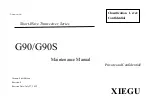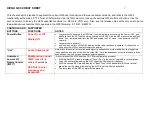
Liquisys M CUM223/253
Basic safety instructions
Hauser
5
1
Basic safety instructions
1.1
Requirements for the personnel
‣
Installation, commissioning, operation and maintenance of the measuring system must
only be carried out by trained technical personnel.
‣
The technical personnel must be authorized by the plant operator to carry out the
specified activities.
‣
The electrical connection may only be performed by an electrical technician.
‣
The technical personnel must have read and understood these Operating Instructions
and must follow the instructions they contain.
‣
Measuring point faults may only be rectified by authorized and specially trained
personnel.
Repairs not described in the enclosed Operating Instructions may only be carried out
directly at the manufacturer's or by the service organization.
1.2
Designated use
Liquisys M is a transmitter for determining the turbidity and the solids content of a liquid
medium.
The transmitter is particularly suited for use in the following areas:
• Drinking water treatment
• Water treatment
• Condensate treatment
• Sewage treatment plant
• Chemical industry
• Pharmaceutical industry
Any other use than the one described here compromises the safety of persons and the entire
measuring system and is, therefore, not permitted.
The manufacturer is not liable for damage caused by improper or non-designated use.
1.3
Workplace safety
As the user, you are responsible for complying with the following safety conditions:
• Regulations for explosion protection
• Installation instructions
• Local standards and regulations
Electromagnetic compatibility
With regard to electromagnetic compatibility, this device has been tested in accordance with
the applicable European standards for industrial applications.
The electromagnetic compatibility indicated only applies to a device that has been connected
in accordance with the instructions in these Operating Instructions.
1.4
Operational safety
‣
Before commissioning the entire measuring point, make sure all the connections are
correct. Ensure that electrical cables and hose connections are not damaged.
‣
Do not operate damaged products, and safeguard them to ensure that they are not
operated inadvertently. Mark the damaged product as defective.
‣
If faults cannot be rectified, the products must be taken out of service and secured against
unintentional commissioning.






































